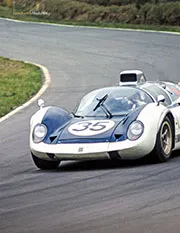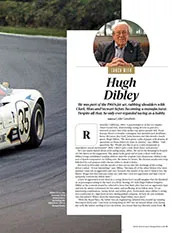

Lunch with... Hugh Dibley
Riverside, California, 1964. A psychologist is at the Los Angeles Times Grand Prix, interviewing racing drivers as part of a research project into what makes top sports people tick. From Europe there’s…
MORE ABOUT THE PUSHER
S1L—Although these remarks on the article “fhe Pusher—Why not Revive it ? ‘ published in the May MOTOR SPORT are rather late, and probably too lengthy to publish, they may be of some possible interest.
Let us commence by considering the various requirements of a light aeroplane from the private owner’s point of view. The main ones are as follows :-1, Low initial cost. 2, Low running cost. 3, Reasonably high cruising speed. 4, Low landing Speed. 5, Ability to carry a comparatively large useful load. 6, Safety—in which I include reasonable protection for the crew in minor ‘,-crashes. 7, Comfort. 8, Good field of vision. 9, Accessibility. 10, The occupation of small hangar space. The article suggests a high-wing cantilever monoplane, but the illustration shows a strutted parasol monoplane, so both types will come under consideration. If we assume that a Gypsy III engine is fitted, as the sketch suggests, the running costs would be comparable with a Gypsy or Puss Moth, although the cruising-speed would be rather less, due to the drag of the tail-boom struts, and to the fact that the airscrew is running in disturbed air. The cantilever type would be superior in this respect, since the parasol machine has a considerable length of strut exposed. The next two factors, numbers 4 and 5, have some relation to each other. Monoplanes often have rather a higher wingloading than biplanes, which means higher landing speeds, but there is no reason why the machine should not carry two passen
gers and 100 pounds of luggage, with enough petrol for three hours flying, and have a landing-speed of about 45 m.p.h. The next item is safety, and here is the snag of the pusher, for not only is there nothing in front of the cockpit to take the brunt of the crash, but the crew are liable to literally’ get it in the neck ‘ from the engine if it comes adrift from its mounting. I must confess, however, that I have seen three twin-engined machines crash, and in each case the man in the nose was thrown clear, and received only minor injuries ; the engines, being outboard, missed the crew though. On the other hand, detail 7, comfort, is,far superior in the pusher, as your contributor points out. Engine noise and airscrew thrash are reduced to a minimum, but the absence of twisted wind’ is the greatest factor. One need never wear goggles, and the ability to put one’s head outside ‘the office’ whilst not wearing them makes for much easier landing. Visibility, too, would be even better than from the Puss Moth, were tandem seating employed But as regards accessibility, one would apparently have to state’ doubled up under the wing to do a job of work on the engine, which does not make for easy work. Pinally, the parasol machine would presumably have folding wings, but the cantilever type would seem to demand more hangar space than many private owners or clubs have to spare.
Destructive criticism is of very little use, so I will try and make some suggestions for getting over the chief drawbacks.
A really strong bulkhead between the engine and the cockpit should solve the danger from a shifting engine in minor crashes. And since aerodynamically, the cantilever wing is much to be preferred, this type of wing could be made quickly detachable from the machine. This would solve both the question of engine accessibility and of hangar space. It would take slightly longer than folding the wings of, say, a Moth does, since it would involve disconnecting the aileron controls, the pilot tubing, and the electric leads to the navigation lights, if fitted, but some form of quickly detachable connection could be used. Even so, I have to admit that it would be a difficult job in a strong wind. Portable supports to prevent damage to the detached wing could be carried behind the cockpit when not in use.
Let us add wheel brakes and a tail wheel, since brakes make taxy-ing in a strong sidewind easier, do away with the need for chocks when running up the engine, and may-save the machine from running into some obstacle after landing, and the tail wheel causes less strain when landing, and gives an improved take-off, as well as enabling the machine to be pushed about without the need of a tail trolley.
There, I think, we have a very nice little machine, which should sell well, once prejudice had been overcome. But let us have tandem seating, and not side-by-side. Having flown both types, I very much prefer the former, for its better visibility, especially in bad weather and at night.
Iraq. 3rd June. 1932. MYLITA.